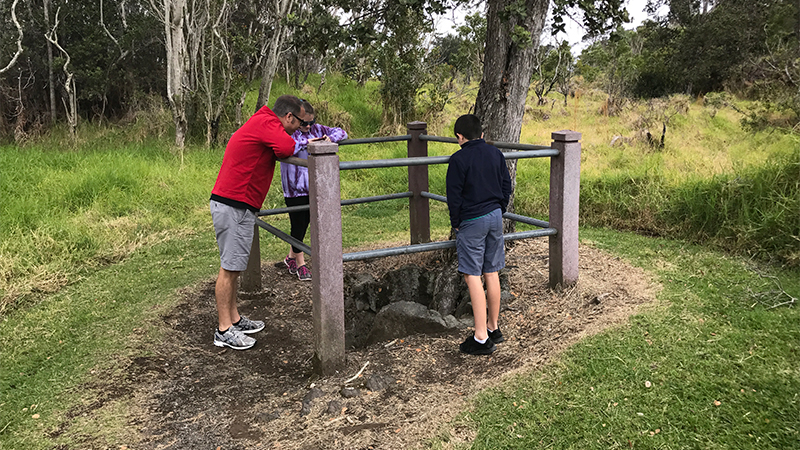
By the end of our second full day in Hawai’i Volcanoes National Park, we were exhausted. We had already visited Jaggar Museum, Kīlauea Overlook, Steaming Bluffs, Sulfur Banks, and Hilina Pali Overlook, and Keanakāko’i Crater, but had about an hour left before dinner, so we hopped in the car and drove over to the Lava Tree Molds.
The Lava Tree Molds hike isn’t really a hike, it’s an easy, 0.2 mile, semi-shady loop walk along the road to view several tree molds.
Tree Molds Road is a narrow, curvy, single-land road shaped like a lollipop. You’ll follow the road to a one-way split, turn right to enter the loop, and follow it all the way around to a small parking lot. From here, you can walk in either direction around the paved loop to see several lava tree molds — some were right next to the parking area.
Lava tree molds are holes in the ground where trees once stood before being engulfed by lava and burning up after the lava around them cooled.
Koa and Ohi’a trees surround the area and guard rails surround the largest and most prominent lava tree molds, one of which had another new tree growing out of it. Ranging from 11 feet deep to almost 25 feet deep, the depth of the tree molds give you can idea of just how much lava poured into this area long ago to raise the ground level.
While exploring the area and checking out each of the lava tree molds, we did notice a few smaller molds that were not fenced off, so if you visit this area, watch where you walk and keep a close eye of your children so no one gets hurt.
The Difference Between Lava Trees And Lava Tree Molds
Lava trees and lava tree molds are both created the same way: Molten lava quickly flows into an area, surrounding the trees. The cool trees cause the lava to harden around them, while the heat from the lava causes the trees to burn, leaving a hollow vertical space in the hardened lava.
What happens next determines whether lava trees or lava tree molds will be created.
- When the molten lava very quickly drains away, Lava Trees, like the ones we saw in the Mauna Ulu Spallter Zone remain.
- If the molten lava remains, it hardens and raises the ground level, leaving behind the lava tree molds, which are deep holes in the ground where trees once stood.
Lava trees and lava tree molds are both very rare, but the molds are the most rare because usually the holes get filled in over time.
Know Before You Go
- Lava Tree Molds is located on Tree Molds Road, 3.1 miles from the Kīlauea Visitor Center, opposite HWY 11 (Mamalahoa Highway) from the majority of Hawai’i Volcanoes National Park attractions and vista points.
- To get here, turn off HWY 11 onto Mauna Loa Road and after 0.5 miles, turn right on Tree Molds Road to reach the Lava Tree Molds loop.
- Lava Tree Molds are very rare and there are several along this loop.
- Be careful to not accidentally step into any of the tree molds as some are up to 25 feet deep!
- There are no restrooms or facilities.
- While the lava tree molds are cool, the area feels fairly neglected when compared with the rest of Hawai’i Volcanoes National Park. Some of the lava tree molds have new trees growing out of them, but the rest are covered in spider webs or full of fallen leaves, debris, and even trash.




